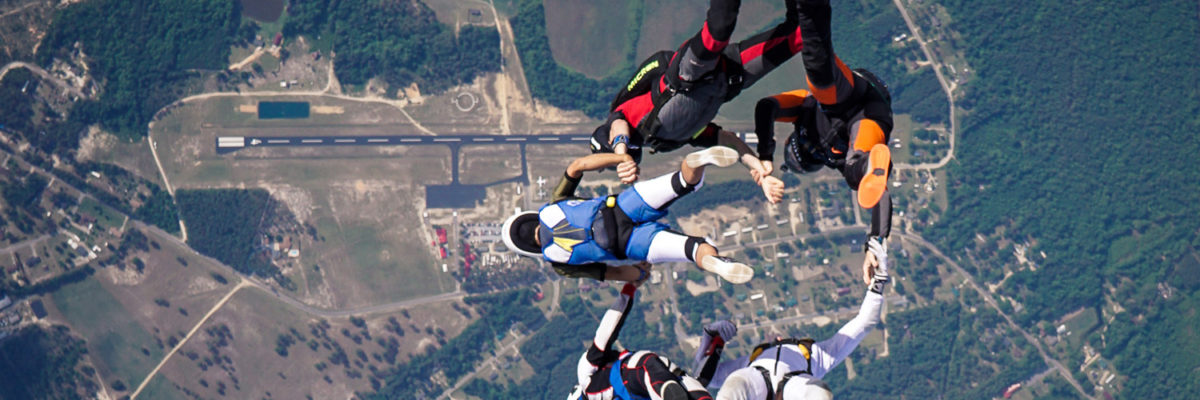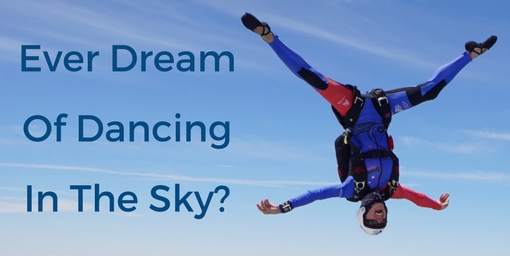
Frequently Asked Questions
Answers to Most Commonly Asked Questions
Your Skydiving Questions Answered
Have questions about skydiving? Our team of expert skydiving instructors have been skydiving North Carolina for years, so we’re well placed to answer your skydiving FAQ’s today.
We understand that skydiving for the first time is a big deal. Chances are, you’ve got skydiving questions you’d like to ask – and chances are, someone else has asked them before, too!
Below, you’ll find answers to some of our most frequently asked questions about tandem skydiving as well as our learn to skydive PSP training program.
If you have any additional questions about skydiving in North Carolina, please feel free to get in touch or give us a call at (910) 904-0000 and we’ll be happy to help.
Requirements
- Are there any physical requirements?
As with any sport, the better shape you are in the easier it will be and the more fun you’ll have. However, we’ve taken people with many different disabilities. If you have a special requirement, call us! We can make your dream of flight come true!
If you have a special medical concern, please contact your doctor.
- How long will I be on the dropzone?
For weekend reservations allow yourself to spend the entire day. Tandem classes last 10-15 minutes. After the class, the time it takes for you to jump has a few variables such as weather, if we are busy that day, and when you signed in. Ideally a tandem jump can be completed in half a day but be prepared to spend the entire day.
- Is there a weight requirement?
Yes. Exemptions can be made but tandem jumps should be limited to 230lbs. For the student program, the weight limit is 250lbs. In very rare circumstances it may be unsafe to take a passenger even if under the weight limit if the harness doesn’t fit correctly. Rarely, exemptions can be made by the instructor, who will determine if an individual over 250lbs can be taken without exceeding safety parameters.
- Is there an age requirement?
There is no maximum age but you must be at least 18 years of age regardless of parental consent. There are no exceptions to this rule. A valid photo ID (drivers license, state ID, or passport) is required to sign up for class. If you do not have an ID you will not jump.
Payment
- What type of payment do you accept?
Visa, MasterCard, Discover, Amex, or Cash (ATM on site). Sorry, NO CHECKS.
Skydiving
- What happens if the parachute doesn't open?
Although it is unlikely that your main parachute will fail to open properly, it does sometimes occur and this is a common question. According to federal law, every jumper must be equipped with a main and a reserve parachute. In addition, all Skydive Paraclete XP equipment are equipped with an Automated Activation Device (AAD), which will automatically open the reserve parachute should the jumpers be unable to.
- What kind of parachute will we use?
The parachutes used today bear little resemblance to the classic round parachutes of years past. Today, nearly all jumpers use “ram-air” parachutes. These are rectangular in shape and, when open, act like an airplane wing. They are more like gliders than umbrellas. The aerodynamics of the parachute provides it with exceptional maneuverability, allowing the jumper to land almost anywhere he/she wishes. This wing shape is also what makes the tiptoe soft landings possible.
- What’s the landing like?
Most landings are quite soft, with most people doing a soft sliding sit-down landing. Under certain conditions and at the discretion of the Instructor, some people make a gentle stand-up landing.
- How fast do you fall?
The average human body falls approximately 120 miles per hour.
- How long does the skydive last?
Up to 60 seconds in freefall and about 5-7 minutes under canopy.
- What will the skydive feel like?
The sensation of freefall is more like flying than falling, and is intensely exciting and liberating. The canopy flight is peaceful and relaxing.
- Is skydiving safe?
Skydiving is like any other extreme sport: there are inherent risks that require careful training and execution. Failure to follow that training can lead to serious injury or death. Skydiving is as safe as the individual(s) make it. The equipment has improved considerably over the old-style round parachute and is so reliable that, when used properly, skydiving can be as safe or safer than any other extreme sport.
Photos and Video
- Can we get one video for our whole group?
No, the time/distance gap between jumper exits preclude a camera person from being able to film more than one student at a time.
- Can I get a video or photographs of my jump?
Yes. We can provide you with videos that have been edited to music and include a pre-jump interview. We also provide high definition digital stills of your skydive.
- Can I bring my own camera with me on the jump?
No, it is against USPA safety regulations. Also, you are much too busy with your skydive to look after your cameras. It very easily may get lost or broken and we cannot risk dropping it in freefall or under parachute.
Learn to Skydive
- I want to get my skydiving license, where do I start?
The first thing you need to do is sign up for a First Jump Course (FJC) by calling 910 904 0000. This course covers all theoretical and practical training necessary to prepare you for your first solo skydive. All aspects of your jump including equipment, aircraft procedures, exit procedures, freefall, deployment, canopy control, and dealing with malfunctions should they occur, will be taught. We also incorporate wind tunnel training. To ensure that you get the most out of your first jump and to accelerate your progression we practice basic body flight in our wind tunnel before your first solo skydive.
- When do classes take place?
Classes typically take place every other Friday and start at 5.30 PM. You should expect to spend 5 hours at our facility that day. The course continues on Saturday morning and prepares you to make your first jump that day (weather depending)
- What if I can’t make it to the scheduled class?
We strongly recommend making arrangements to attend the regular classes. If this is absolutely not possible we will try to schedule something for you. Call the office at 910 904 0000 or email robbie@flyxp.com.
- Where to classes take place?
The first jump course takes place at our training center at Skydive Paraclete XP located at:
Raeford Municipal Airport 28376 Raeford, NC
We will also take advantage of our indoor training facility Paraclete XP located at:
190 Paraclete Drive 28376, Raeford, NC
- Who may participate in the Paraclete Student Program?
You must be at least 18 years old, weigh no more than 250 lbs. and be reasonably fit. You also must be able to provide a government issued photo ID.
- Do I have to do a tandem before starting the program?
No. We do not require that you make a tandem skydive before starting the PSP program although we strongly recommend it. Every tandem jump counts towards your jump total.
- I’ve been in the tunnel before, do I have to do the tunnel portion of the PSP program?
We are glad that you have had the experience of body flight before. However, we will need you to go through our student specific tunnel training. Your training will be with one of our skydiving instructors and you will work on specific skills to prepare you for your first jump.
- How many jumps are in the program?
The program consists of 18 jumps. During these jumps all requirements to apply for an A-license will be met (must reach a total of 25) By completing all levels you will be set up for a successful continuation of your skydiving journey.
- How many jumps can I make in 1 day/week?
It depends on many factors like weather, daylight, timing and your personal mental and physical abilities but typically people make anything between 1 to 5 jumps in a day.
- How long does it take to get a license?
It can take from a few weeks to a few months, often depending on the weather and your availability. Please be aware that jumps must be made within 30 days of each other to avoid retraining or repeating earlier jumps.
- Do I get video of my jumps?
Yes! Your instructor will wear a camera for all of your jumps to use during debriefs. We will provide a flash drive so you can take your videos home. All videos are included in the price.
- What should I wear?
Athletic clothing and closed toes shoes that allow unrestricted movement is recommended.
- What kind of gear will I be using?
You will be supplied with all the equipment you need for your PSP jumps. Including a parachute, jumpsuit, helmet, goggles, altimeter and log book. The gear we use is the best gear available on the market and maintained very well by our highly experienced rigger.
- I have my own gear, can I use it?
Until you have your A-license you will use the gear from the school.
- I have a GoPro, can I wear it?
No. Besides a few other requirements, skydivers must have at least 200 jumps to wear any kind of camera equipment.
- What do I do in case of bad weather?
We recommend that you show up anyway. The weather can always get better and if you are not here, the chances that you get to jump are nonexistent. Besides, as much as possible we will try to work on ground theory, A-license tests or organize a packing class.
- What does Skydive Paraclete XP consider bad weather?
Conditions that affect the postponement, delay or cancellation of PSP skydives are clouds, rain and wind.
- How much does it cost to skydive after I get licensed?
Once you have your A-license the cost will be $29 per jump. This does not include gear rental.
- I’ve done a few training jumps at another drop zone or a long time ago. Where would I start in your training program?
Previous training will integrate with our program in different ways depending on what your training was and how long ago. Please email our instructor robbie@flyxp.com to discuss your individual situation.
- I went to Military Freefall School, what does it take to become a licensed skydiver?
You are at the right place! Many of our instructors have experience with military freefall school and are very familiar with your needs. Everything depends on your situation but typically the transition can be done easily. We offer a transition class followed by instructional jumps by one of our USPA certified instructors. Email robbie@flyxp.com for more information or to schedule a class.
Ready to Go Skydiving?
Copyright © 2025, Skydive Paraclete XP, All Rights Reserved.
DropZone Web Design & Marketing by Beyond Marketing, LLC
